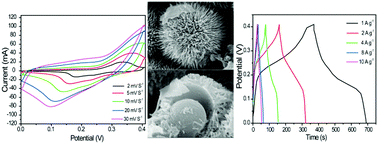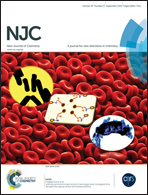Rattle-type NiCo2O4–carbon composite microspheres as electrode materials for high-performance supercapacitors†
Abstract
In this work, NiCo2O4–carbon composite microspheres with rattle-type structure were successfully prepared by a template-engaged hydrothermal and subsequent calcination treatment. These rattle-type microspheres are composed of a solid carbon core and a porous shell with nanorods as building blocks. The calcination temperature of the NiCo2O4–carbon precursor has an obvious effect on the morphology as well as the resultant capacitive performances. Because of their unique structure and high specific surface area, these rattle-type NiCo2O4–carbon composite microspheres exhibited excellent electrochemical performances with high specific capacitance (790 F g−1 at 1 A g−1), and it even reached as high as 609 F g−1 at 10 A g−1. Additionally, excellent cycling stability with 99.4% specific capacitance retention after continuous 2000 cycles at a current density of 2 A g−1 was observed, suggesting their promising application in supercapacitors. The synergistic effect of different components and the rattle-type structure may contribute to the outstanding performance of the composite electrode.


 Please wait while we load your content...
Please wait while we load your content...